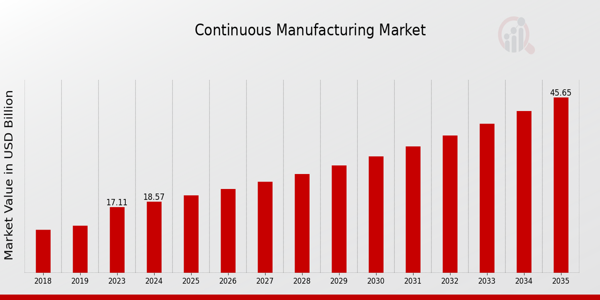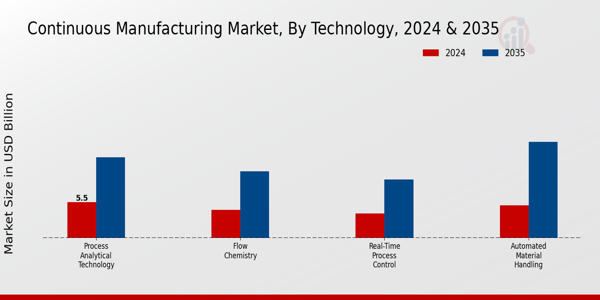Continuous Manufacturing Market Overview
As per MRFR analysis, the Continuous Manufacturing Market Size was estimated at 17.11 (USD Billion) in 2023. The Continuous Manufacturing Market Industry is expected to grow from 18.57 (USD Billion) in 2024 to 45.67 (USD Billion) by 2035. The Continuous Manufacturing Market CAGR (growth rate) is expected to be around 8.52% during the forecast period (2025 - 2035).
Key Continuous Manufacturing Market Trends Highlighted
The Continuous Manufacturing Market is witnessing significant growth driven primarily by the demand for efficient production processes and cost reduction. This manufacturing approach offers greater flexibility and consistency compared to traditional batch manufacturing, allowing companies to respond quickly to market changes. The rise of automation and advanced technologies plays a crucial role in enhancing production capabilities. Additionally, increasing regulatory pressures and the need for higher quality standards are prompting manufacturers to adopt continuous processes that can better control variables and reduce human error. Opportunities abound for stakeholders in the continuous manufacturing sector, particularly in the pharmaceutical and food industries.
As more companies seek to adopt lean manufacturing principles, the transition to continuous systems presents a chance to streamline operations and improve product quality. With increasing investments in research and development for innovative manufacturing technologies, companies can explore new applications and expand their market presence. Collaboration between technology providers and manufacturers can lead to tailored solutions that meet specific industry needs, further accelerating the adoption of continuous manufacturing methods. Recent trends indicate a shift towards sustainability in manufacturing processes. Companies are increasingly focused on reducing waste and energy consumption, which aligns with sustainability goals.
Moreover, the integration of artificial intelligence and machine learning in continuous manufacturing systems is improving process optimization and predictive maintenance. This results in lower operational costs and increased product throughput. As industries embrace digital transformation, the continuous manufacturing market stands to benefit from enhanced data analytics capabilities, which can lead to better decision-making and increased competitiveness in an ever-evolving landscape.

Source: Primary Research, Secondary Research, MRFR Database and Analyst Review
Continuous Manufacturing Market Drivers
Increasing Demand for Efficiency and Cost Reduction
The Continuous Manufacturing Metabolism Market is expanding rapidly due to the increased need for greater efficiency and reduced costs in the construction industry. Businesses are adopting continuous manufacturing techniques in an effort to increase efficiency, maximize savings, and increase the utilization of resources. This new trend of moving from conventional batch processes to continuous operations allows for a much smoother production process with greater speed to market and reduced production expenditure.
Continuous manufacturing enables better control of the processes and uniformity of the outputs, which is vital for compliance and even more important for clients. The ongoing pressure to enhance margins drives manufacturers to search for new ways of producing. Continuous manufacturing offers significant advantages and is, therefore, a more appealing prospect. There are expected to be both investment and technological changes to improve the methods of achieving continuous manufacturing so as to make the market even more competitive and, therefore, more efficient.
Seeking this change is likely to improve margins and environmental sustainability, which is expected to drive the Continuous Manufacturing Metabolism Market forward.
Technological Advancements in Manufacturing Processes
The Continuous Manufacturing Market Industry is greatly influenced by rapid technological advancements. Innovations such as automation, real-time data analytics, and advanced process control systems are reshaping manufacturing capabilities. These technologies enable manufacturers to monitor processes continuously, make data-driven decisions, and respond swiftly to production anomalies. Integrating smart technologies into continuous manufacturing not only increases efficiency but also enhances the safety and reliability of operations, further driving market growth.
As companies seek to gain a competitive edge, staying abreast of these technological developments becomes crucial.
Rising Regulatory Requirements
The increasing complexity of regulatory requirements in various industries is a significant driver for the Continuous Manufacturing Market Industry. Manufacturers are under pressure to comply with stringent regulations related to product safety, quality, and environmental sustainability. Continuous manufacturing provides a solution by offering better control over processes and improved documentation, helping companies meet compliance standards more efficiently.
As regulatory landscapes continue to evolve, the demand for continuous manufacturing technologies that enhance compliance and traceability will grow, fostering market expansion.
Continuous Manufacturing Market Segment Insights:
Continuous Manufacturing Market Technology Insights
The Continuous Manufacturing Market demonstrates robust growth within the Technology segment, poised to increase from a valuation of 18.57 USD Billion in 2024 to 45.67 USD Billion by 2035. This market is characterized by its diversity, featuring various technologies essential for enhancing efficiency and productivity in manufacturing processes. The Process Analytical Technology segment holds a significant position in the market with a valuation of 5.5 USD Billion in 2024, expected to rise to 12.5 USD Billion in 2035, reflecting its pivotal role in optimizing process monitoring and control.
This segment is crucial as it combines real-time data analytics with manufacturing, facilitating improvements in quality and compliance across various industries. Similarly, the Flow Chemistry aspect presents substantial importance, valued at 4.3 USD Billion in 2024 and projected to increase to 10.3 USD Billion in 2035. This technology enhances reaction efficiency and safety in chemical processes, showcasing its value in the pharmaceutical sector, where the demand for rapid development cycles is growing. Real-Time Process Control technology, valued at 3.8 USD Billion in 2024 and anticipated to reach 9.0 USD Billion by 2035, is integral in the market as it allows manufacturers to respond immediately to changes in operating conditions, thereby ensuring consistent quality and minimizing waste.
Furthermore, the Automated Material Handling segment, with a valuation of 5.0 USD Billion in 2024, rising to 14.87 USD Billion by 2035, is becoming increasingly dominant. This growth is driven by its ability to improve operational efficiency and reduce labor costs through automation, making it critical for industries aiming for lean manufacturing. Overall, the Continuous Manufacturing Market segmentation highlights the importance of each technology, where Process Analytical Technology and Automated Material Handling stand out for their substantial market shares and impact on efficiency enhancement, thereby contributing significantly to the overall market growth trajectory.
The growth drivers in this segment include the increasing demand for automation, sustainability practices, and the urgent need to optimize manufacturing processes. However, challenges such as implementation costs and the need for a skilled workforce to operate advanced technologies also exist. The opportunity lies in advancements in technology that promise to deliver further efficiencies and increased production capabilities, influencing the future trajectory of the Continuous Manufacturing Market and its various segments significantly.

Source: Primary Research, Secondary Research, MRFR Database and Analyst Review
Continuous Manufacturing Market Industry Insights
The Continuous Manufacturing Market is projected to reach a valuation of 18.57 USD Billion in 2024, showcasing significant growth potential across various industry segments. The pharmaceutical industry is a major contributor, driven by the need for consistent quality and efficiency in drug manufacturing processes. The food and beverage sector also plays a vital role, with continuous manufacturing techniques enhancing productivity and minimizing waste during production. The chemical industry is increasingly adopting these methods to ensure timely delivery and adhere to stringent regulations.
Biotechnology benefits from continuous manufacturing by enabling faster innovation cycles and improved scalability, thereby enhancing product availability in the market. The Continuous Manufacturing Market data reveals that these segments are not only essential for meeting consumer demand but also for offsetting challenges such as resource scarcity and fluctuating market conditions. Key trends driving the market include automation, technological advancements, and sustainability initiatives, which collectively underscore the importance of continuous manufacturing in maintaining operational efficiency and competitive advantage within the Continuous Manufacturing Market industry.
Overall, understanding the Continuous Manufacturing Market segmentation helps to identify lucrative opportunities while navigating the complexities inherent in each industry sector.
Continuous Manufacturing Market Process Type Insights
The Continuous Manufacturing Market, valued at 18.57 USD Billion in 2024, reflects significant advancements in manufacturing efficiency and productivity across various industries. This market is primarily segmented into Process Types, encompassing Continuous Production, Semi-Continuous Production, and Batch Production. Continuous Production is increasingly favored due to its ability to maximize output levels and minimize operational costs, making it a dominant force within the market. Semi-Continuous Production serves as a crucial link between continuous processes and batch processes, providing flexibility, which is valuable in industries with varying product demands.
Batch Production, while traditionally significant within manufacturing, faces challenges in scalability compared to its continuous counterparts yet remains relevant for specific applications needing customization. Overall, the Continuous Manufacturing Market data highlights trends toward automation and sustainability, with growth drivers including the rising demand for efficient production methods and the increasing focus on minimizing waste. However, the industry must navigate challenges such as high initial investments and technological integration.
Insights from the Continuous Manufacturing Market statistics depict a vibrant industry poised for growth and transformation.
Continuous Manufacturing Market Scale of Operation Insights
The Continuous Manufacturing Market is experiencing notable growth across its Scale of Operation segment, projected to be valued significantly by 2024, with a value of 18.57 USD Billion. This segment spans various operational scales, including Pilot Scale, Full Scale, and Lab Scale, each holding unique importance. Pilot Scale operations play a crucial role as they help in the initial phases of manufacturing processes, allowing businesses to optimize techniques before full-scale production. Full Scale is the dominant category, characterized by large-volume output that meets high demand and efficiency requirements in various industries.
Lab Scale operations, while smaller in size, are essential for research and development, where innovative processes and formulations are trialed. The market is driven by increasing demand for efficiency and flexibility in manufacturing processes, while challenges include the need for significant investment in technology and skilled workforce. Opportunities abound as industries seek to adopt continuous manufacturing techniques to enhance productivity, reduce costs, and achieve quicker time-to-market. These dynamics are evident in the Continuous Manufacturing Market revenue and segmentation trends, highlighting the importance of various operational scales in shaping the industry landscape.
Continuous Manufacturing Market Regional Insights
The Continuous Manufacturing Market revenue showcases significant regional distributions, with North America leading at a valuation of 6.1 USD Billion in 2024 and advancing to 15.0 USD Billion by 2035, highlighting its majority holding in the market due to high technological adoption and regulatory support. Europe follows closely, valued at 4.5 USD Billion in 2024 and projected to reach 10.8 USD Billion in 2035, driven by strong pharmaceutical and chemical sectors focusing on continuous processes. The APAC region is notably significant, with a valuation of 5.0 USD Billion in 2024, expected to grow to 12.0 USD Billion by 2035, supported by rapid industrialization and investments in manufacturing technologies.
South America and MEA, while smaller, represent emerging opportunities, valued at 1.5 USD Billion and 1.47 USD Billion, respectively, in 2024, with projected growth to 3.5 USD Billion and 4.37 USD Billion by 2035. The overall Continuous Manufacturing Market statistics reflect diverse growth drivers in each region, influenced by local industry needs, government policies, and technological advancements, presenting a complex yet lucrative landscape for stakeholders vying for market presence.

Source: Primary Research, Secondary Research, MRFR Database and Analyst Review
Continuous Manufacturing Market Key Players and Competitive Insights:
The Continuous Manufacturing Market has seen significant growth and transformation over recent years, primarily driven by advancements in technology, regulatory support, and the increasing demand for more efficient manufacturing processes. Competitive insights within this market reveal a landscape characterized by dynamic shifts as various companies implement innovative strategies to meet evolving consumer needs and regulatory requirements. Continuous manufacturing refers to the integration of various production processes into a seamless flow, allowing for consistent product quality, reduced production costs, and minimized waste. As companies strive to enhance their operational efficiency and agility, competition intensifies, influencing pricing strategies, investment in research and development, and partnerships aimed at leveraging technological advancements.
GSK is recognized for its robust presence in the Continuous Manufacturing Market, showcasing its commitment to innovation and efficiency in pharmaceutical production. The company has made substantial investments in state-of-the-art facilities that support the continuous manufacturing of various drug formulations. GSK’s strength lies in its ability to integrate advanced technologies and process automation, facilitating the rapid production of high-quality pharmaceuticals while ensuring regulatory compliance. Additionally, GSK focuses on collaborative efforts with academic institutions and technology providers, enhancing its capabilities in continuous manufacturing. The company’s strategic shift towards adopting a holistic approach in its production processes not only boosts its operational efficiency but also positions it favorably in a competitive market where speed and quality are paramount.
Cargill, a player in the agriculture and food industry, is making significant strides in the Continuous Manufacturing Market, particularly in the production of food ingredients and additives. The company harnesses its extensive research and development resources to innovate process technologies that enhance the efficiency of continuous manufacturing systems. Cargill's strengths lie in its ability to leverage a diverse portfolio of raw materials and sophisticated processing techniques tailored to meet specific customer needs in the food sector. By implementing continuous manufacturing practices throughout its operations, Cargill is able to streamline production, reduce lead times, and achieve better product consistency. Furthermore, the company emphasizes sustainability in its manufacturing processes, aligning with growing consumer demands for environmentally friendly products, thereby enhancing its competitive edge in a market that increasingly prioritizes sustainability alongside efficiency.
Key Companies in the Continuous Manufacturing Market Include:
- GSK
- Cargill
- Topsoe
- Boehringer Ingelheim
- Shell
- Siemens
- Pfizer
- BASF
- Lonza
- Merck and Co
- FMC Corporation
- AbbVie
- Amgen
- DuPont
- Johnson and Johnson
Continuous Manufacturing Market Industry Developments
The Continuous Manufacturing Market has been witnessing significant advancements and activities recently. Companies such as GSK and Pfizer are pushing the boundaries of continuous manufacturing to enhance production efficiencies and reduce costs in pharmaceutical manufacturing. Cargill, in relation to its bio-based product lines, is also exploring continuous processes that align with sustainability goals. Merck & Co. has been actively developing continuous manufacturing methods aimed at streamlining biopharmaceutical production. Boehringer Ingelheim is making strides in in-situ continuous processing, shaking up traditional batch manufacturing with innovative technologies. In the petrochemical sector, Shell is investing in continuous processes to optimize its supply chain and reduce environmental impact. The market's growth trajectory has been evident with rising valuations, prompting strategic collaborations among players like Amgen and Lonza to innovate and integrate continuous methods into their operations. Mergers and acquisitions remain an ongoing theme as companies seek to expand their capabilities, with particular note of strategic moves by DuPont and Johnson & Johnson towards advancing their continuous manufacturing capabilities. These developments signal a robust interest in modernizing manufacturing while enhancing agility across sectors.
Continuous Manufacturing Market Segmentation Insights
Continuous Manufacturing Market Technology Outlook
Continuous Manufacturing Market Industry Outlook
- Pharmaceutical
- Food and Beverage
- Chemical
- Biotechnology
Continuous Manufacturing Market Process Type Outlook
- Continuous Production
- Semi-Continuous Production
- Batch Production
Continuous Manufacturing Market Scale of Operation Outlook
- Pilot Scale
- Full Scale
- Lab Scale
Continuous Manufacturing Market Regional Outlook
- North America
- Europe
- South America
- Asia Pacific
- Middle East and Africa
| Attribute/Metric Source: |
Details |
| MARKET SIZE 2023 |
17.11 (USD Billion) |
| MARKET SIZE 2024 |
18.57 (USD Billion) |
| MARKET SIZE 2035 |
45.67 (USD Billion) |
| COMPOUND ANNUAL GROWTH RATE (CAGR) |
8.52% (2025 - 2035) |
| REPORT COVERAGE |
Revenue Forecast, Competitive Landscape, Growth Factors, and Trends |
| BASE YEAR |
2024 |
| MARKET FORECAST PERIOD |
2025 - 2035 |
| HISTORICAL DATA |
2019 - 2024 |
| MARKET FORECAST UNITS |
USD Billion |
| KEY COMPANIES PROFILED |
GSK, Cargill, Topsoe, Boehringer Ingelheim, Shell, Siemens, Pfizer, BASF, Lonza, Merck and Co, FMC Corporation, AbbVie, Amgen, DuPont, Johnson and Johnson |
| SEGMENTS COVERED |
Technology, Industry, Process Type, Scale of Operation, Regional |
| KEY MARKET OPPORTUNITIES |
Increased demand for efficiency, Rising regulatory compliance needs, Growth in biopharmaceutical manufacturing, Advancements in automation technology, Expansion in emerging markets |
| KEY MARKET DYNAMICS |
Technological advancements in manufacturing, Rising demand for efficiency, Stringent regulatory compliance requirements, Growing emphasis on sustainability, Increased adoption of automation |
| COUNTRIES COVERED |
North America, Europe, APAC, South America, MEA |
Frequently Asked Questions (FAQ) :
The Global Continuous Manufacturing Market is expected to be valued at 18.57 USD Billion in 2024.
By 2035, the Global Continuous Manufacturing Market is anticipated to reach 45.67 USD Billion.
The market is expected to grow at a CAGR of 8.52% during the period from 2025 to 2035.
North America is projected to hold the largest market value at 6.1 USD Billion in 2024.
The Process Analytical Technology segment is valued at 5.5 USD Billion in 2024.
The Flow Chemistry segment is expected to be valued at 10.3 USD Billion by 2035.
Major players include GSK, Cargill, Boehringer Ingelheim, and Pfizer among others.
The Automated Material Handling segment is expected to be valued at 5.0 USD Billion in 2024.
Europe is projected to reach a market value of 10.8 USD Billion by 2035.
The Real-Time Process Control segment is projected to be valued at 3.8 USD Billion in 2024.
















